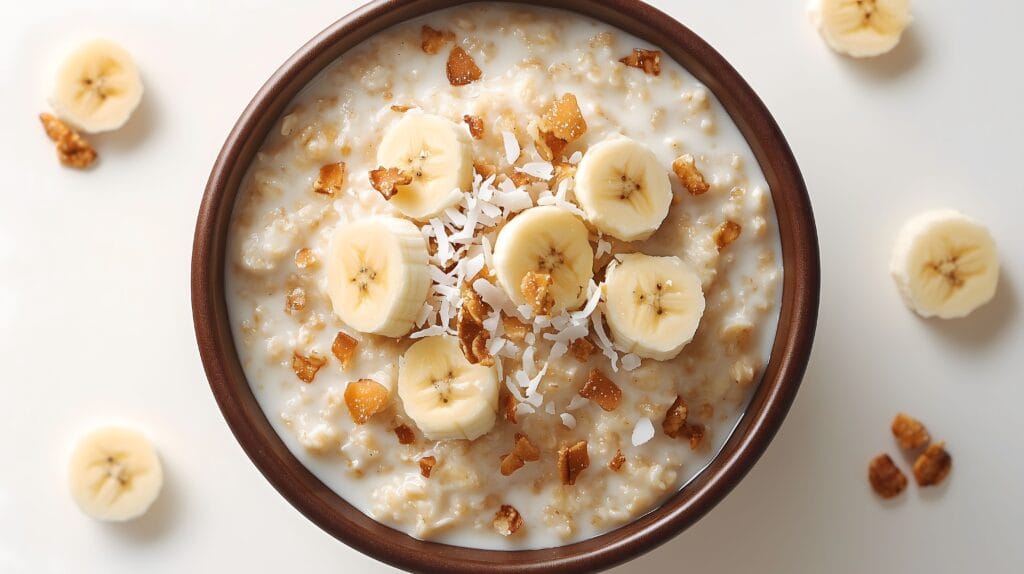Bananas are widely loved and easily accessible, yet they have a somewhat controversial position in the weight loss industry. Many nutritionists praise their nutrient richness and ease of ingestion; however, diets like the ketogenic diet avoid them because of their high carbohydrate content. To help you make an informed choice, this article explores the facts, advantages, and possible disadvantages of including bananas in a weight-loss regimen.
Table of Contents
Bananas’ Nutritious Profile
115–120 g of a medium banana normally contains:

- Calories: 105–113 calories
- Carbohydrates: 27 g of carbohydrates, comprising 3 g of fiber and 14 g of natural sugars
- Potassium: 12% DV for potassium, 17% DV for vitamin C, and 20% DV for vitamin B6
- Other Nutrients: Additional nutrients include trace levels of manganese, magnesium, and flavonoids, which are antioxidants.
A banana’s nutritional composition is influenced by its level of ripeness:
- Unripe (green) bananas: Green, or unripe, bananas are lower in sugar and higher in resistant starch and a healthy prebiotic fiber.
- Ripe (yellow) bananas: Bananas that are ripe (yellow) have more simple sugars, which facilitates digestion.
Five Potential Benefits of Bananas for Weight Loss
- Encourage Fullness and Cut Down on Overeating Because of their high fiber and resistant starch content, bananas promote feelings of fullness and slow down digestion. High-fiber diets have been linked to reduced body weight by reducing hunger hormones such as ghrelin, according to research. For example, combining a banana with protein (like peanut butter) creates a well-balanced snack that lowers cravings and helps control blood sugar.
- Nutrient-Dense, Low-Calorie Snacking Bananas, which provide about 100 calories each, are a portable and filling substitute for manufactured food. Without the useless calories of baked goods or candies, their inherent sweetness can satisfy cravings for sugar. Bananas are frequently suggested by dietitians as a healthy dessert choice or as an energy boost before exercise.
- Increased Metabolism from Resistant Starch Green bananas have a lot of resistant starch, which ferments in the gut and is difficult to digest. Short-chain fatty acids, which are produced during this fermentation process, are associated with decreased fat accumulation and greater fat burning. Resistant starch may enhance insulin sensitivity, which promotes long-term weight control, according to studies.
- Promotes Digestive Health The fiber and prebiotics in bananas support gut flora, which facilitates digestion and lessens bloating. Weight loss is indirectly aided by a healthy gut microbiota, which is linked to better metabolic health and reduced inflammation.
- Changes Recipes’ Added Sugars By naturally sweetening foods like oatmeal, smoothies, and baked goods, bananas can lessen the need for refined sugars, which are linked to inflammation and weight gain. For instance, adding banana to pancake recipes can increase the amount of fiber while reducing the amount of added sugar by 25%.
Possible Negative Effects of Bananas on Weight Loss

- Natural Sugars and Blood Sugar Spikes Blood Sugar Spikes and Natural Sugars Despite being healthier than added sweets, the 14–18 g of natural sugar in a medium banana may produce blood sugar rises in people with insulin resistance, particularly if the banana is overripe. This impact can be lessened by eating bananas with fat or protein.
- Portion Control Challenges Difficulties with Portion Control Up to 150 calories can be found in larger bananas, and consuming too many of them could lead to a calorie surplus. Experts advise consuming no more than one or two bananas daily and balancing them with fruits that are lower in calories, such as berries.
- Individual Variability Personal Variability After eating bananas, some people have severe blood sugar spikes, which can cause hunger crashes. You can find out if bananas are good for your metabolism with personalized nutrition tests, such continuous glucose monitoring.
How to Include Bananas in a Diet to Lose Weight
Astute Recipes and Pairings
- Snack before working out: half a banana with 1 tablespoon of almond butter.
- Post-workout recovery: Greek yogurt and bananas provide protein for post-workout recovery.
- Breakfast: Breakfast consists of chia seeds, banana slices, and overnight oats.
- Dessert: Banana ice cream made with just one ingredient (frozen bananas blended).

Ripeness Is Important
- Green bananas: Green bananas have less sugar and more resistant starch.
- Ripe bananas: Excellent for supplying energy for strenuous exercise or as a sugar substitute in dishes.
Tips for Portioning
- Choose bananas that are small to medium in size.
- To save waste, freeze extra portions for smoothies.
Professional Advice for Optimizing Advantages
- Pair with Protein or Fat: Combine with fat or protein to increase satiety and decrease the absorption of sugar.
- Time Spent on Exercise: Enhances Recuperation and Energy Use.
- Track Blood Sugar Reactions: Modify consumption in accordance with individual tolerance.
- Put Variety First: Swap out bananas for fruits with less sugar, such as apples and berries.
Conclusion
When eaten carefully, bananas can be a beneficial complement to a diet plan for weight loss. Their nutrient richness, fiber, and resistant starch aid in digestion, satiety, and energy requirements. However, because of their high calorie density and sugar content, moderation is essential, especially for people with insulin resistance. You can reap the benefits of bananas without sacrificing your weight-loss objectives by eating them with proteins, keeping an eye on portion sizes, and giving preference to unripe bananas.














